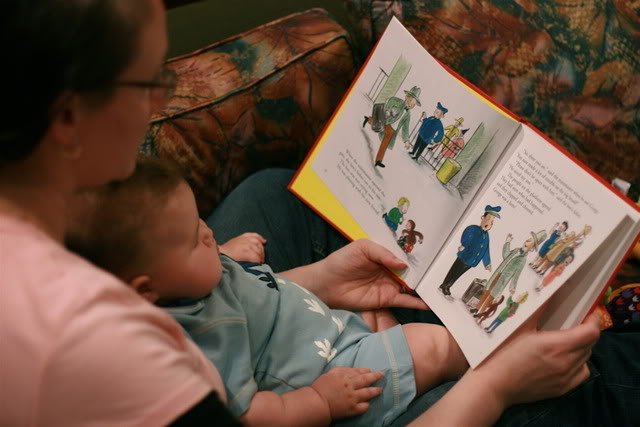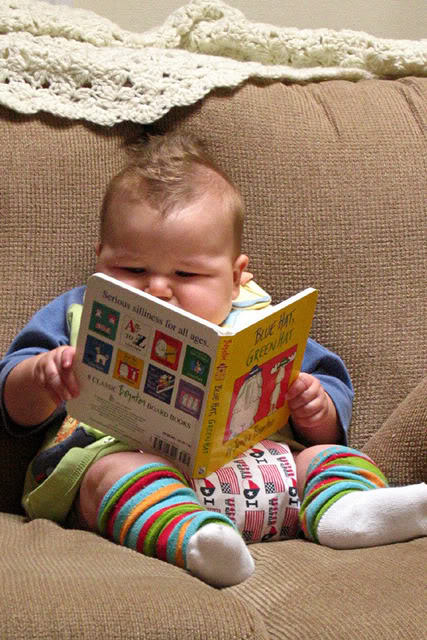This post was written for inclusion in Bilingual for Fun's Blogging Carnival on Bilingualism, hosted this month by Spanglish Baby. Check back at Spanglish Baby for the carnival when it posts Feb. 25!

I forgot just how chubby he used to be.
Check out those excellent arm grooves!
As I mentioned in "Two-year-old's favorite books: Bus & bear, flaps & flights," sometimes I cheat by making my own bilingual books.
See, it's hard to find German-English books on the cheap when you live in the US (or, I imagine, other non-German-speaking countries), and the library has only a small selection available in each age range. If the minority language in your house is, say, Spanish when you live in the US or French when you live in Canada, it will likely be easy to round up quite a few options for bilingual reading time. But if you're stuck with a less trendy second language for your region — and you don't have unlimited book-buying funds — you have to make do.
The way I've done it with my baby and now toddler is by finding English books that are simple enough for me, a non-native German speaker, to translate into German on the fly. He doesn't know that I'm not reading what's on the page, and I have a fun way to insert the minority language into our reading time.
Now, sure, this technique works only on beginners in the target language, and it doesn't reinforce visual reading skills. Plus, it's fun to read actual German children's books to Mikko. So I'm compiling tips for a future post about how you can gather some bilingual books on a budget.
But for now, I thought I'd do a little round-up of books that meet my criteria for switcheroo bilingual reading:
- They should be readily available to you in a typical English-speaking country, at the bookstore as well as at the library. They might be on your very own bookshelf at this moment!
- They should be entertaining to your young'un (baby to preschool age, or theoretically a beginning learner who's older).
- And they should be uncomplicated enough in grammar and vocabulary that even we non-native speakers can translate as we go.
If you aren't strong in the minority language, you can review the books beforehand and visit an online bilingual dictionary. If you wanted, you could even scribble your translations into the margins, or cover up the English words entirely with your own labels.
These tips can also work for parents using baby sign language with their infants or toddlers (or using American Sign Language as a minority language), because it's equally hard to find sign-language storybooks for kids. I've seen a few out there, but it's not something you come across at every corner. These books below are simple enough for even novice signers (like me!) to throw in what they know, same as non-native bilingual speakers (like me!).
Ready?
 I mentioned this one in my other article, but it bears repeating. I Love You Through And Through,
I mentioned this one in my other article, but it bears repeating. I Love You Through And Through,Sarah from Alphabet Garten was kind enough to send me (and other lucky duckies) this version of Hänsel & Gretel (yes, in actual German) from her online German children's bookshop as a limited-time incentive for signing up for the Alphabet Garten forums. A belated thank-you to Sarah! Mikko loves it, because it's got flaps! Flaps galore, on every page. Little hidden
 creatures and secrets that send him on a treasure hunt every time we read. You might not luck into free flap books
creatures and secrets that send him on a treasure hunt every time we read. You might not luck into free flap books 

 There's a lot in the way of animal vocabulary at our house, but Mikko seems to love it. Another is a very cute children's book without much in the way of dialogue: Good Night, Gorilla,
There's a lot in the way of animal vocabulary at our house, but Mikko seems to love it. Another is a very cute children's book without much in the way of dialogue: Good Night, Gorilla,Commenters to my post on good two-year-old books mentioned Sandra Boynton, and I was astonished I'd failed to give her a mention. Blue Hat, Green Hat

Mikko reading Blue Hat, Green Hat to himself at 15 weeks old. The kid's a genius. Or propped up by his blubber. One or the other.
 I've loved Big Dog...Little Dog,
I've loved Big Dog...Little Dog,

If your minority language is uncommon in your country and you've been able to find any books at all in that language at the local bookstore, I'm going to take a wild guess and say — you have some picture dictionaries! That's all I can reliably find in German at bookstores

I have mixed feelings toward word books, without story to connect the vocabulary. I say mixed, because before having an actual child with whom to interact with them, I used to find them quite boring as a reader, but now I see how much delight Mikko takes in them. In fact, his favorite book for some time was First 100 Words, presumably because he could sign almost every one of those words. It was such a treat for him to point to a picture of say, a monkey, then sign it (scratch your armpits) and make an "eee, eee, eee" sound (that's what a monkey sounds like, natch), then wait for me to repeat it back to him and say "monkey" out loud several times to show I understood. ... Mikko goes ga-ga over the pages with trains, a recent obsession. He'll start saying "choo choo" and making the train sign (rubbing two fingers from each hand together) while I feverishly and obediently flip pages. Once I find the right one: "Train! Choo choo!" His joy is worth every hour spent poring over word books.So there you have it. Despite all my sighing over picture dictionaries, they might just be the gateway to bilingual heaven for your baby.
You can even make your own word book in your target language. Check out this tutorial on Muse of the Morning on making your own dictionary (via Alphabet-Garten). This is an especially good craft for a young elementary-school child who's learning to read and write, or you could create your own for a younger child.
An easy book to make with materials on hand is a photo book of relatives. I've made a few
 of these for Mikko, using extra brag-book type photo albums I had around the house and prints I ordered online for the purpose. Since we live an extended distance away from our appropriately termed extended family, I wanted to make sure Mikko had a ready set of reminders of faces and names. This is super easy to translate, because all you have to know is the vocabulary of familial relations, such as grandmother, uncle, and cousin.
of these for Mikko, using extra brag-book type photo albums I had around the house and prints I ordered online for the purpose. Since we live an extended distance away from our appropriately termed extended family, I wanted to make sure Mikko had a ready set of reminders of faces and names. This is super easy to translate, because all you have to know is the vocabulary of familial relations, such as grandmother, uncle, and cousin. Another good topic for a homemade photo flip book is daily activities, showing your child going through the routine tasks of the day. You might make a special effort to photograph each step, such as getting dressed, brushing teeth, going to a playdate, eating lunch, etc., and then placing the prints in order, or maybe arranged by days. That would be a good way to go over daily vocabulary in your target language (or, again, in baby sign language) and also emphasize your routines, which many young kids find comforting.
I hope that helps give you some ideas for easy, cheat-cheat-never-beat bilingual reading. Look around your shelves or your library for other simple books that will work in the same way, and let me know if you come across other good options!









 I'm Lauren Wayne, writer and natural parent. I embrace attached parenting with an emphasis toward green living.
I'm Lauren Wayne, writer and natural parent. I embrace attached parenting with an emphasis toward green living. 


6 comments:
amazon.com often runs great deals on children's books & has a pretty decent selection of foreign language books. i love amazon because you never pay tax & if you spend $25 (if you buy only from amazon - none of their outside sellers), you get free shipping.
i love reading your blog. thanks for keeping us informed!
Thanks, Lauren! I will definitely include Amazon in my list, then! It's so nice to have the internet, isn't it? It's funny, but I actually do have to pay sales tax, because I live in the state they're located in. Sigh. But I still shop from them, anyway, and always try for the free shipping. I'll mention that you can buy from Marketplace sellers and get Super Saver Shipping if their items are fulfilled through Amazon. I know this, because I'm a Marketplace seller who uses that service! :) It's a nice way to get cheaper deals on some items.
P.S. No, we don't sell children's books, so I'm not drumming up business for myself in particular...
I had no idea that you were one of their sellers. I'll have to check out your shop!
i love that picture of mikko propped up being a genius!!
thanks for all the recommendations. we have excellent luck finding bilingual books at our 1/2 price book stores in the area too.
Great tips! I am lucky that I can find a ton of Spanish books at our library but I sometimes have to translate books from English if they aren't available.
I just wanted to add that you can take this a bit farther and instead of translating on the fly, which works well for simple books, you could actually translate the book and pasting the translation into the pages either over the English or next to it. It worked great for me with The Cat in the Hat. Working out the rhymes was a bit tough, good thing my brother is very gifted. Yet, rhymes are essential in many children's books. It may be worth it to do with great books that will quickly become child favorites in the target language.
Post a Comment